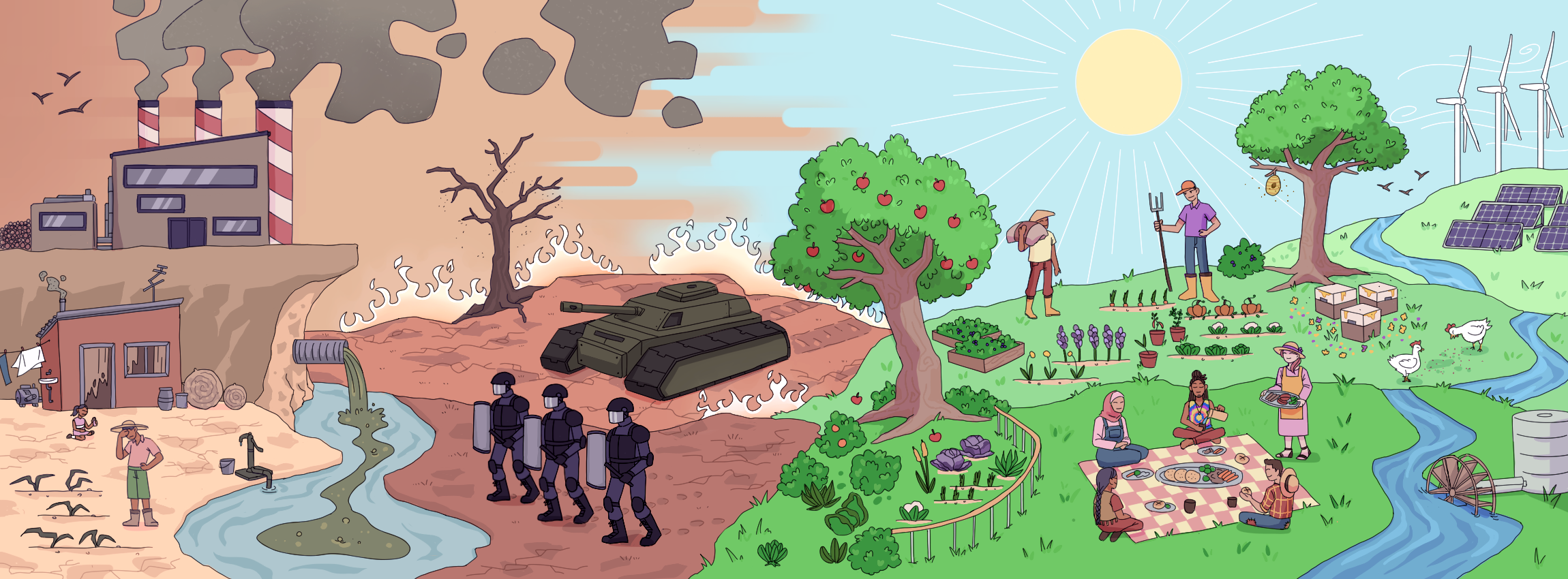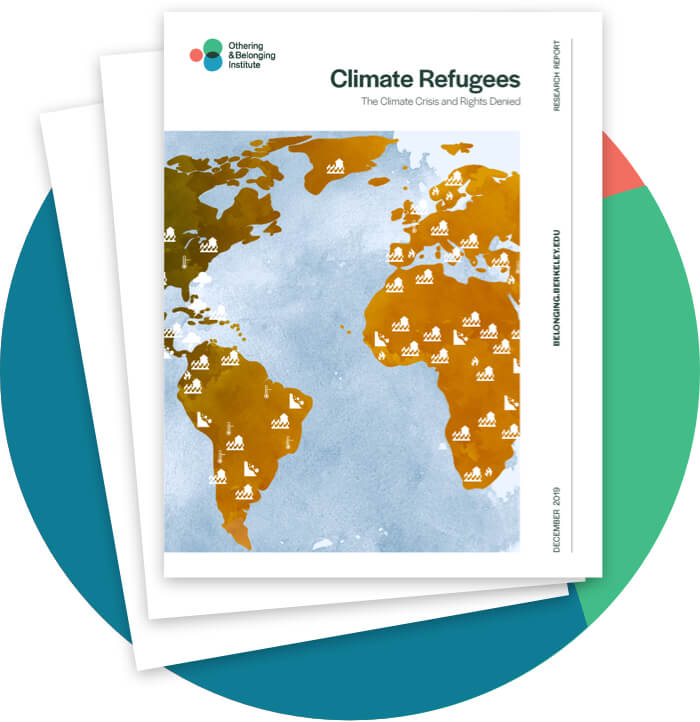Bhutan
Introduction to Bhutan
Bhutan, a small, landlocked country in south-central Asia, has a population of 787,424,1 of which 56% is rural.2 Lying in the foothills of the Himalayas, the northern region faces a tundra climate, the northwestern region faces a warm summer humid continental climate, and the rest of the country faces a subpolar oceanic climate.3 Bhutan is subject to extreme natural disasters like flash floods, glacial lake outburst floods (GLOFs), and storms.4 Due to its rural, mountainous geography, Bhutan has remained a lower-middle-income country for several decades, with steady poverty and inequality levels, while the tourism sector and the growth of the non-hydropower industry have led to minimal economic growth.5 The capital and largest city, Thimphu, only accounts for 15.7% of the country’s population,6 and nearly half of its residents work in the government bureaucracy.7 The service and industry sectors comprise 51.2% and 31.8% of GDP, respectively, while the agriculture sector comprises 14.7%.8 Once Bhutan was guaranteed its independence from the British in 1910, India quickly swooped in and established a "special relationship" between the two countries.9 This has led India to have sizable control and influence over the country in political, economic, and security fields.10
Mapping Major Climate Events and Climate-Induced Displacement
Bhutan is extremely susceptible to the effects of the climate crisis, ranking as the 34th most vulnerable country.11 Rising temperatures are a key challenge for Bhutan, as future temperature projections are higher than the global average: 3.9°C compared to 3.7°C.12 This, in turn, has severe ramifications for the country, as Bhutan has over 700 glaciers that make up 1.6% of the territory,13 where higher temperatures lead to a melting of glaciers that causes GLOFs. This is seen by the increased presence of proglacial lakes—formed from retreating glaciers14 —as 22% of glaciers were lake terminating in 2019, compared to just 14% in 2000.15 Further, glaciers are melting at a rate of 30-60 meters per decade,16 and there have even been reports of “supra-glacial lakes forming.”17 Additionally, over 70% of agricultural and infrastructure settlements are located near or on the main glacier drainage basins, making them extremely vulnerable to GLOFs.18 Heavy seasonal monsoon rains and GLOFs cause over 7,700 people to be affected by flooding annually, which is expected to reach 10,700 by 2030 under current projections.19 There have been over 18 GLOF events in Bhutan since the 1950s20 and over 32 extreme weather events since 2016.21 Currently, the median probability of a heat wave occurring in Bhutan is 2%, but rising temperatures can cause this to rise to between 20-36% based on future emissions.22 Overall, South Asia faces a 149% to 276% rise in heat-related deaths, which has telling implications for the Bhutanese people who are so accustomed to a cooler climate.23 The escalation of the climate crisis will disproportionately affect farmers, rural groups that cannot get the necessary tools and technologies for adaptations, and communities that live downstream of glaciers.23
Mapping the Costs of the Climate Crisis
The GDP of Bhutan is $2.90 billion,24 while the GDP per capita is $3,704.25 Although Bhutan graduated from Least Developed Country (LDC) status in 2023, the climate crisis can further exacerbate its financial situation. Flooding’s impact on health and livelihood is expected to cause anywhere between $33 million and $41 million in damage to the annual GDP.22 If the world continues on its current emissions path, this would result in an average economic loss of 1.4% of GDP by 2050 and 6.6% by 2100.26 Nearly 24 glacial lakes are at current risk of overflow, and if they do, it could impact several communities, farms, and a significant proportion of the hydropower sector, severely limiting Bhutan’s power usage and exporting abilities.27 This is especially pertinent, as hydropower is a crucial sector for Bhutan, accounting for 14% of GDP and 26% of annual revenue.28 The agricultural sector will also be heavily impacted, as although it makes up a small proportion of GDP, it accounted for nearly 55.8% of total employment in 2019.22 With 31% of agricultural activities in sloped areas, the sector is extremely susceptible to increased landslides and soil erosion resulting from the climate crisis, which can impact the livelihoods of thousands of Bhutanese.29 Further, rice is a Bhutanese staple and constitutes 49% of its national food basket,29 yet it is highly vulnerable to changes in climate; future temperature rise can cause rice yields to decline by 22% by 2080.30
Mapping Resilience and Mitigation Pathways
Despite being responsible for less than 0.01% of global GHG emissions,31 Bhutan continues to work towards reducing emissions and mitigating the damage of the climate crisis. With 72.3% of the country covered by forest and enacting strict environmental policy,22 Bhutan became the world’s first country to reach carbon neutrality in 2011.32 It is also one of the world’s only carbon-negative countries since its forests act as carbon sinks that absorb nine million tons annually, while the economy emits only about two million tons.33 Bhutan’s constitution also mandates that at least 60% of the country should always be forested so it remains a carbon-negative country.34 By 2035, Bhutan also targets to become the first country to achieve 100% organic agriculture production,35 helping mitigate the climate crisis by using less energy, emitting lower emissions, and lowering the risk of environmental degradation and pollution.36 As a global leader in the fight against the climate crisis, Bhutan generates nearly 99.5% of its electricity through hydropower sources and is the only South Asian country with excess surplus energy,37 leading the country to export 80% of generated energy to neighboring India.22 Bhutan’s parliament, the Chi Tsogh, is also taking its own measures, as it stopped using plastic water bottles, aims to go entirely paperless, and observes a “zero waste hour” once a month where all officials help clean and recycle waste.38
Necessary Changes
Although Bhutan is already on an excellent track for sustainable goals as a carbon-negative country, it must continue to identify and implement new adaptations for its future as the climate crisis will undoubtedly impact the country. The first change must be in its hydropower sector; high reliance on a single energy source can lead to extreme vulnerabilities for energy security in the wake of the climate crisis, as infrastructure will be directly exposed to GLOFs and long-term changing rates of sedimentation, water reserves, and flow.22 This can severely impact domestic energy production and export revenues. This is evident right now, as decreased monsoon rains and reduced river flow in the winter months cause Bhutan to import electricity from India since hydropower generation cannot match domestic demand.39 Utilizing and developing other renewable energy sources, such as solar, wind, and geothermal infrastructure, can help address this issue. Although abundant electricity is produced, nearly 70% of energy in rural and urban areas is supplied through fuelwood, highlighting the need to ensure that fuelwood supplies are managed in sustainable and efficient ways.40 Water usage is also a significant challenge for Bhutan, as rapid population growth, seasonality of precipitation, and higher temperatures all place increased pressure on water resources, highlighting the necessity for more effective water management and resilient strategies.22 Bhutan’s national environment strategy, The Middle Path, states that hydropower development, industrial growth, and intensification of agriculture are the three key areas the country must focus on to face the climate crisis.41 It also recognizes that its main vulnerabilities lie in forestry and biodiversity, natural disasters and infrastructure, and the water and energy sectors, emphasizing the need for targeted strategies. However, many of these adaptations are expensive, costing an estimated $3.45 million to lower the level of just one of the country’s dangerous glacial lakes.27 With dozens of glacial lakes, many of which will likely reach a “dangerous level” in the future, lowering all levels would be costly and impractical. There is a high financial cost to this, as Bhutan’s energy sector is expected to see a rising gap between supply and demand that would cause its annual adaptation bill to triple from $10 million to $28 million.42 Social changes must also be addressed, as Bhutan has historically persecuted the Nepali-speaking Hindu minorities, causing many of them to seek refuge in neighboring Nepal and India.43 Emphasizing cultural pluralism, writing more inclusive citizenship laws, and having accountability can reintegrate these refugees while improving Bhutan’s image in the region.
Citations
- 1“Population, total – Bhutan,” The World Bank, December 7, 2024,
https://data.worldbank.org/indicator/SP.POP.TOTL?locations=BT. - 2Rural Population, total – Bhutan,” The World Bank, accessed December 7, 2024,
https://data.worldbank.org/indicator/SP.RUR.TOTL.ZS?locations=BT. - 3“Climate Change Knowledge Portal – Bhutan,” The World Bank, accessed December 7, 2024,
https://climateknowledgeportal.worldbank.org/country/bhutan. - 4 “Bhutan is protecting its vital infrastructure systems by strengthening resilience to disasters,” UNDRR, accessed December 7, 2024,
https://www.undrr.org/news/bhutan-protecting-its-vital-infrastructure-s…. - 5“Bhutan Overview,” The World Bank, accessed December 7, 2024,
https://www.worldbank.org/en/country/bhutan/overview#:~:text=Economic%2…. - 6“SUTI report for Thimpu City,” UNESCAP, accessed December 7, 2024,
https://www.unescap.org/sites/default/files/Thimphu.pdf. - 7“City profile Thimphu,” Elsevier, accessed December 7, 2024,
https://www.sciencedirect.com/science/article/abs/pii/S0264275109000195…. - 8“Bhutan,” CIA Factbook, accessed December 7, 2024,
https://www.cia.gov/the-world-factbook/countries/bhutan/#:~:text=GDP%20… - 9“How India tries to interfere in and take control of Bhutan,” Global Times, accessed December 16, 2024,
https://www.globaltimes.cn/page/202303/1287280.shtml. - 10Ibid (i)
- 11“Bhutan - Country Index,” Notre Dame Global Adaptation Initiative, accessed December 7, 2024,
https://gain-new.crc.nd.edu/country/bhutan
- 12"Climate Risk Country Profile: Bhutan,” Asian Development Bank, accessed December 7, 2024,
https://www.adb.org/sites/default/files/publication/722636/climate-risk…. - 13“700 glaciers in Bhutan according to a new study,” Bhutan Broadcasting Service, accessed December 8, 2024,
https://www.bbs.bt/700-glaciers-in-bhutan-according-to-a-new-study/. - 14“Proglacial Lake,” World Landforms, accessed December 8, 2024,
https://worldlandforms.com/landforms/proglacial-lake/. - 15“Shrinking glaciers in Bhutan,” Antarctic Glaciers, accessed December 8, 2024,
https://www.antarcticglaciers.org/wp-content/plugins/antarcticglaciers-… - 16“Bhutan - Climate Change Adaptation,” UNDP, accessed December 8, 2024,
https://www.adaptation-undp.org/explore/asia-and-pacific/bhutan#:~:text…. - 17“Climate change in Bhutan,” National Center for Hydrology and Meteorology Bhutan, accessed December 8, 2024,
https://www.nchm.gov.bt/home/pageMenu/781#:~:text=Heavy%20seasonal%20mo…. - 18Ibid (ii)
- 19“Climate Risk Country Profile: Bhutan,” Asian Development Bank.
- 20“GLOF hazard, exposure, vulnerability, and risk assessment of potentially dangerous glacial lakes in the Bhutan Himalaya,” Journal of Hydrology, accessed December 8, 2024,
https://www.sciencedirect.com/science/article/abs/pii/S0022169423002536. - 21“How Climate Change is Quietly Rewriting Bhutan's Future,” The Climate Reality Project, accessed December 8, 2024,
https://www.climaterealityproject.org/blog/how-climate-change-quietly-r… - 22 a b c d e f g “Climate Risk Country Profile: Bhutan,” Asian Development Bank.
- 23 a b Ibid (iii): 22
- 24“GDP (current US$) - Bhutan,” The World Bank, accessed December 8, 2024,
https://data.worldbank.org/indicator/NY.GDP.MKTP.CD?locations=BT. - 25GDP per capita (current US$) - Bhutan,” The World Bank, accessed December 8, 2024,
https://data.worldbank.org/indicator/NY.GDP.PCAP.CD?locations=BT. - 26“Melting Glaciers, Climate Extremes Threaten Bhutan's Future - Report,” Asian Development Group, accessed December 8, 2024,
https://www.adb.org/news/melting-glaciers-climate-extremes-threaten-bhu…. - 27 a b “Melting Glaciers, Climate Extremes Threaten Bhutan's Future - Report,” Asian Development Group.
- 28“Sustainable Energy : Is Hydropower the Answer?” The Druk Journal, accessed December 8, 2024,
https://drukjournal.bt/sustainable-energy-is-hydropower-the-answer/#:~:…. - 29 a b Ibid (iiii): 31
- 30“Melting Glaciers, Climate Extremes Threaten Bhutan's Future - Report,” Asian Development Group.
- 31“Greenhouse Gas Emissions in Bhutan,” Emission Index, accessed December 9, 2024,
https://www.emission-index.com/countries/bhutan. - 32“Carbon Negativity In Bhutan: An Inverse Free Rider Problem,” Harvard International Review, accessed December 9, 2024,
https://hir.harvard.edu/carbon-negativity-in-bhutan-an-inverse-free-rid…. - 33Ibid (v): 37
- 34“How Bhutan is addressing climate change,” Inter-Parliamentary Union, accessed December 9, 2024,
https://www.ipu.org/news/case-studies/2023-05/how-bhutan-addressing-cli…. - 35“Bhutan's challenges and prospects in becoming a 100% organic country,” Heinrich Böll Foundation, accessed December 9, 2024,
https://hk.boell.org/en/2022/09/08/bhutans-challenges-and-prospects-bec…. - 36“Why is organic better for the planet?” Soil Association, accessed December 9, 2024,
https://www.soilassociation.org/take-action/organic-living/why-organic/…. - 37“Bhutan's Hydropower Sector: 12 Things to Know,” Asian Development Bank, accessed December 9, 2024,
https://docs.google.com/document/d/1ahrGBJPBk4Coq9ZtaDGkjMRoGkwG87HyL9X… - 38“How Bhutan is addressing climate change,” Inter-Parliamentary Union.
- 39“Bhutan gearing up to import electricity from India for extended period: Report,” The Economic Times, accessed December 9, 2024,
https://energy.economictimes.indiatimes.com/news/power/bhutan-gearing-u… - 40“Biomass Fuel Efficiency – Bhutan,” UNFCCC, accessed December 9, 2024,
https://unfccc.int/climate-action/momentum-for-change/activity-database… - 41“Bhutan,” Global Support Programme (NAP-GSP), accessed December 9, 2024,
https://www.globalsupportprogramme.org/explore/bhutan. - 42Ibid (VI): 50
- 43“Transitions without Justice: Bhutanese Refugees in Nepal,” The International Journal of Transitional Justice, accessed December 16, 2024,
https://academic.oup.com/ijtj/article/18/2/267/7633472#479833243


